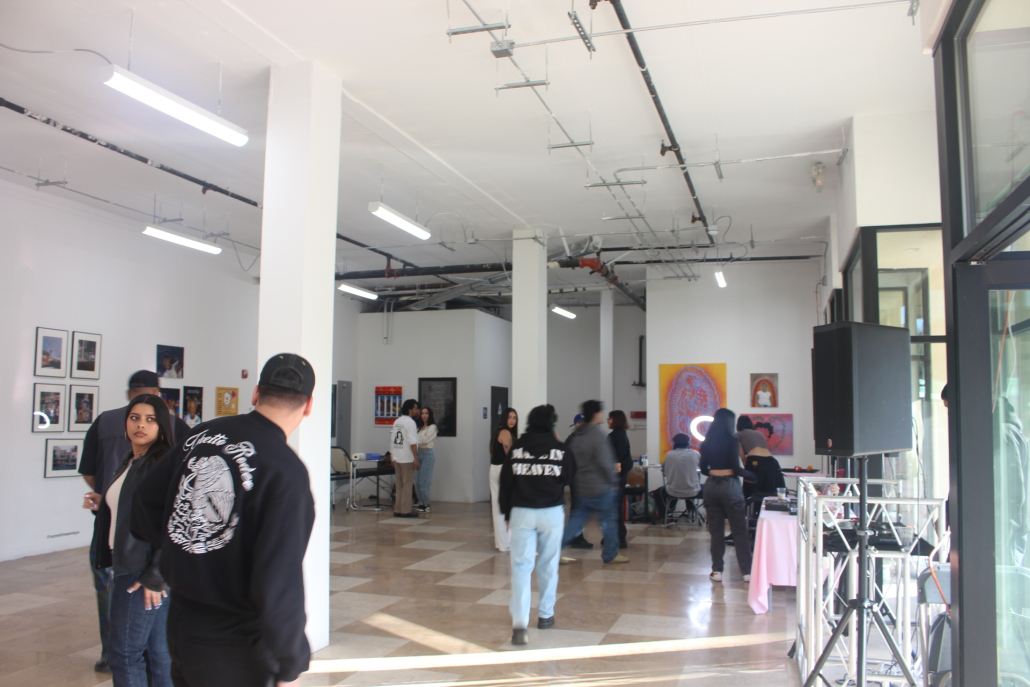Ghetto Rodeo is more than streetwear

It’s safe to say that Ghetto Rodeo’s showroom grand opening revived Latine culture in East Los Angeles Saturday. The Californian sun seemed to be shining brightly on the El Sereno neighborhood of East L.A. Families and friends relished the perfect weather by gathering at 4671 Huntington Drive to indulge in unique forms of social advocacy.
Ghetto Rodeo kicked off the celebration with brand owner Brian Saucedo performing a ribbon-cutting ceremony. The entire event spanned from 12 p.m. to 8 p.m. with an after-party following the showroom’s closure. The event’s clean structure created a safe and welcoming environment for guests to partake in everything Ghetto Rodeo has to offer, and the community did not have trouble resonating with the event.
Ghetto Rodeo as a brand is able to produce distinctive pieces in a consistent manner like no other streetwear brand in the fashion game. As a philanthropic organization, Ghetto Rodeo promotes and provides a community like no other. The brand’s goal to redefine the beauty standard and re-write stereotypes for the Latine population creates a genuine attempt to make the world better for future generations. However, unlike many other organizations with the same mission, Ghetto Rodeo will succeed.
“Being a Latina myself, coming here made me feel super welcome because of a lot of the art that’s out here, the music, the food, the people,’’ said Letty Manriquez, an attendee of the event and L.A. native. “It feels like home, I don’t feel unfamiliar.”

The event was separated into three main sections taking up two buildings and a small-sized parking lot. Focusing on community engagement, the parking lot became the hub for guests to gather and speak with each other. At the outside portion of the event, Ghetto Rodeo offered food, drinks and a mechanical bull. The taco vendor on the front side of the lot contributed to a swap meet festival kind of atmosphere.
The flow of people into the first building led into a white room bursting with the sound of a blend of Latin and hip-hop music coming from the DJ set up in the center point. The rest of the fairly big room was filled with tattoo artists and individual art galleries. At the very left of the room was a collection highlighting the beauty of the average blue-collar male Latino worker. The collection featured pictures of male blue-collar workers in Los Angeles, from construction worker to custodian.
Another section of the gallery depicted the plight of minority communities in L.A. in past and current times through the development of film taken from disposable cameras. The room ended with a section dedicated to two tattoo artists open for business.
“The whole brand of Ghetto Rodeo is a tribute to my older brother because without him I wouldn’t know anything about my representation,” Saucedo said. “He taught me everything I know about my culture.”
The preservation of culture is something that Ghetto Rodeo does extremely well. It’s as if the brand encapsulated what it means to be a Mexican in L.A. who wants more for the community.
“I was always into fashion and one thing I noticed in fashion and in Hollywood is the lack of representation there is for brown people,” Saucedo said. “I wanted to make a difference.”
A difference is surely felt. In about a year and a half, Ghetto Rodeo has spurred from an idea to a dominant streetwear brand with its very own showroom.
“A lot of kids who grew up in worse environments than me, who grew up in the ghetto, being called ghetto, we’re only programmed to know one thing. How to be a gangster or a cholo because it’s how they portray us,” Saucedo said.
It’s with that in mind that shoppers should look at the array of clothing Ghetto Rodeo offers. The brand resonates with the Mexican community of L.A but does not feed into stereotypes.
Ghetto Rodeo includes a lot of references to L.A. in their backdrops in the majority, if not all of, their marketing campaigns. Saucedo describes Ghetto Rodeo as a representation of “the real faces of our real culture.” Ghetto Rodeo gives representation to the Mexican communities of L.A. while normalizing Latine beauty.
The main attraction took place in the farthest building from the lot. Upon entering the sizable warehouse-style room, guests were greeted with a telling collection that featured unique forms of expression through hoodies, t-shirts, jeans and more. The core collection of the gallery, located at the center of the room, featured the soon-to-be iconic “I [red heart] Latinas.” Simple yet effective, this t-shirt collection highlights the beauty behind Latina women, which tends to be forgotten when it comes to beauty standards.
Another classic piece featured in the collection comes in the form of a t-shirt and hoodie. The brown-colored clothing items located on the front right side of the room had no graphics. It simply presents a white-lettered font that reads “NO ONE IS ILLEGAL ON STOLEN LAND” on the front with “FUCK I.C.E” and “GHETTO RODEO” on the back. This t-shirt, although simple in design, is straight to the point and weighs heavy with meaning — like many other current and prior Ghetto Rodeo pieces.
Jannie Maciel, gallery worker and long-time friend of Brian Saucedo, explains that “everything [Saucedo] does is with good intention. I feel like that’s very important and why he’s so successful” Given the recent brand success, it’s safe to say Brian Saucedo seems to be carrying out the brand’s meaning.

